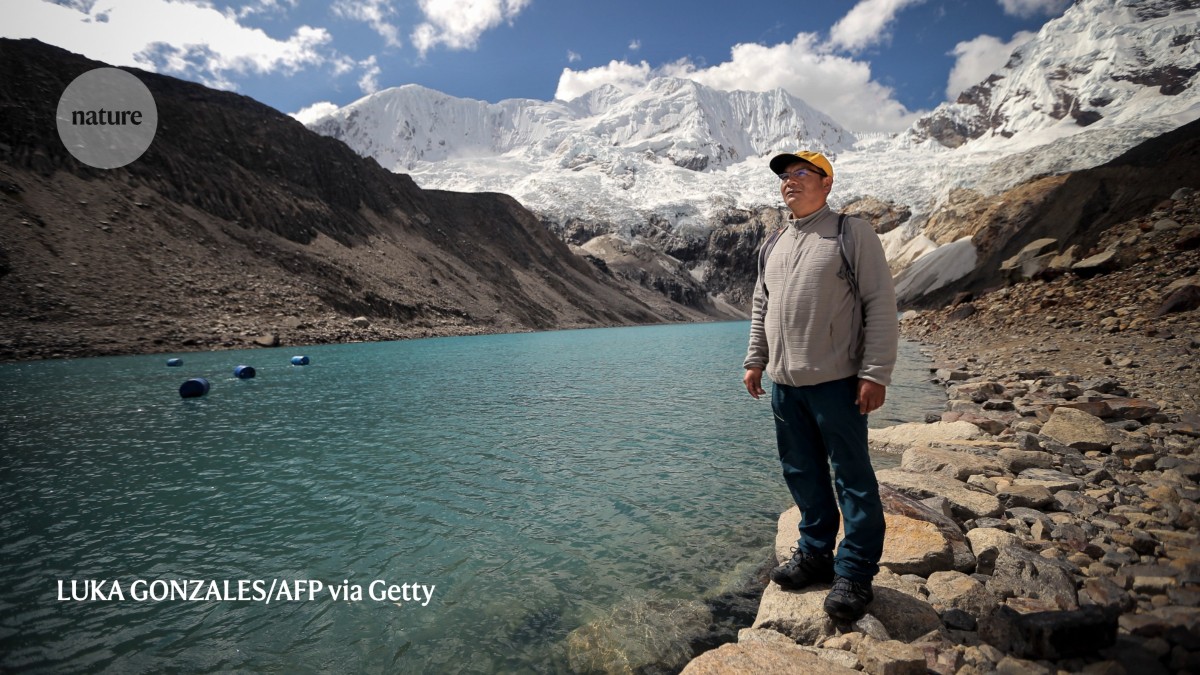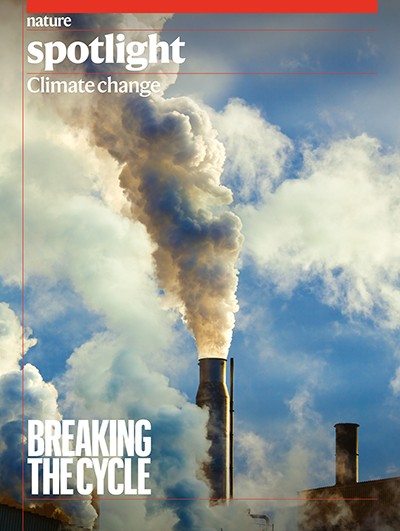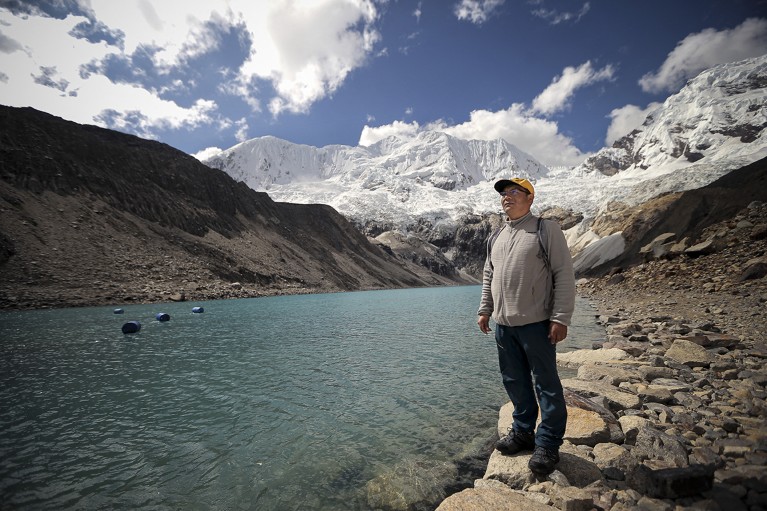
Saúl Luciano Lliuya’s home town of Huaraz in Peru is threatened by flooding from a glacial lake.Credit: Luka Gonzales/AFP via Getty
From the smiles, bouquets and cheers among the crowd gathered outside the Higher Regional Court of Hamm in Germany on 28 May, it might have looked like those present were celebrating a win. In fact, they had just lost a ten-year legal battle.
In 2015, Saúl Luciano Lliuya, a mountain guide from the alpine town of Huaraz in Peru, sued German multinational energy giant RWE for its contribution to global warming, which threatened Lliuya’s home with flooding from a nearby glacial lake. The case had numerous setbacks over the ensuing decade, but the final blow came on 28 May. The court dismissed the latest appeal, saying the likelihood of a flooding event reaching Lliuya’s home and causing serious damage was too low to justify legal intervention.
Yet, outside the courtroom on that fateful day, Lliuya’s lawyer Roda Verheyen declared jubilantly to waiting reporters, “I’m so happy”. The reason for her celebration was that the court decision created a bombshell precedent: major greenhouse-gas emitters could be held liable for costs of damage in the future, on the basis of their proportional contribution to global emissions. “This ruling shows that the big polluters driving the climate can finally be held legally responsible for the harm they have caused,” Lliuya said in a statement.
Nature Spotlight: Climate change
Noah Walker-Crawford, a social anthropologist at the Grantham Research Institute on Climate Change and the Environment in London, who was initially involved in the Lliuya v. RWE case, says that those involved never thought it would get as far as it did, especially on scientific grounds. “When we started the case, the science wasn’t that far along yet, so on attribution we only had broad insight,” he says.
In 2015, climate-attribution science was still in its infancy. The field investigates the extent to which human-induced climate change alters the likelihood or intensity of a particular climate-related event. For example, a flood triggered by a melting glacier, a heatwave that kills thousands of people, sea-level rise that destroys coastal properties or a forest fire that razes a town. Ultimately, it also provides a way to apportion blame for discrete climate events to individual entities, such as a company or government.
As the Lliuya v. RWE case progressed, so too did the attribution science. “The case ended up taking so long that the science caught up,” Walker-Crawford says. In particular, a study1 published in 2021 found that the melting and retreat of the Palcaraju glacier and the increased risk of a glacial lake outburst flooding nearby Huaraz — Lliuya’s home — was “entirely attributable” to human-induced global warming.
That flipped both the science and the law. Many of those working in attribution science and applying it in the courtroom see the Lliuya v. RWE decision as a landmark one that gives the field legal weight, opening the door for the science to have its day in court.
Cause and effect
August 2003 was the hottest European summer in around 500 years. Heatwaves broke temperature records across the continent, rivers dried up, forest fires raged, glaciers melted and an estimated 20,000 people died from heat-related illness.
One year later, a study concluded with extremely high confidence that human-induced climate change had at least doubled the risk of such an extreme heatwave occurring2. The paper is considered the first peer-reviewed, published climate-attribution study of an extreme weather event.
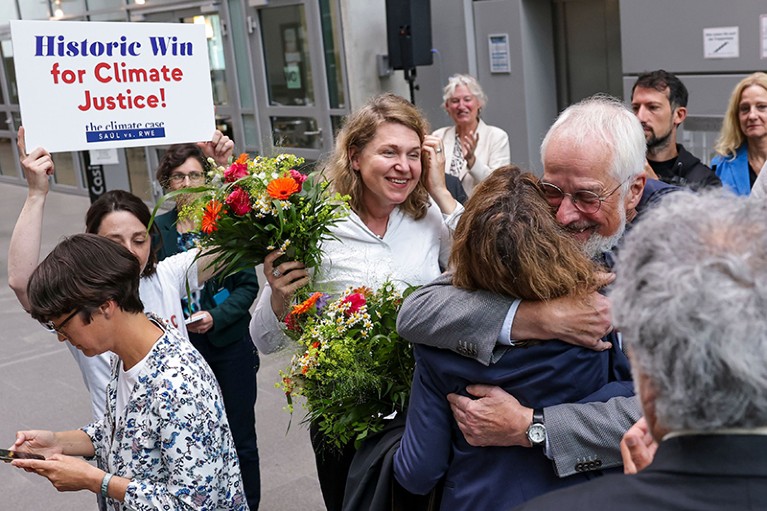
Lawyer Roda Verheyen (centre) was happy with the decision in the Lliuya v. RWE lawsuit.Credit: Christopher Neundorf/EPA-EFE/Shutterstock
“The overarching question we always try to answer is whether and to what extent human-induced climate change altered the likelihood and intensity of the event,” says Friederike Otto, a physicist at the Grantham Institute for Climate Change and the Environment in London.
Quantifying how much of the blame for extreme weather events and the damage caused can be attributed to human-generated greenhouse-gas emissions is complex. It starts with modelling what the climate would be like without the estimated 50% increase in atmospheric carbon dioxide that has occurred since pre-industrial times (see go.nature.com/3jeqwae), then comparing the difference with data from current climate models.
Climate models are therefore at the core of attribution science. These are computational simulations of Earth’s climate, applying mathematical equations that represent the laws of physics — the conservation of mass, energy and momentum — to real climate data. Models allow scientists to study the complex processes and interactions that shape climate and weather at various points in time and space, and the effects of changes, such as increasing atmospheric CO2.
In climate models, one particular equation is key: the Navier–Stokes equation, which describes the forces acting on a fluid particle. “So you have the Coriolis force, you have gravity, you have friction, and that equation is the basis of every single climate model,” Otto says.
But no two climate models are alike. “At the core they’re all the same, but they might have a different spatial resolution,” says Sarah Perkins-Kirkpatrick, a climate scientist at the Australian National University in Canberra. That resolution can make a world of difference, especially when it comes to small-scale meteorological processes. We can’t resolve clouds, for example, unless we’re using climate models that are less than four cubic kilometres in resolution, Perkins-Kirkpatrick says. “The finer the resolution, the better we can represent those processes, which are important.”
Climate models are technically global but each one is refined in its own way to most accurately represent a particular region or climate process, Otto says. “The UK Met Office one, for example, they adjust the parameters so that the model does give a very good representation of the climate in the UK, and that is usually to the detriment of somewhere else in the world,” she says. For example, until a few years ago, the climate model used for the United Kingdom didn’t describe the monsoon over India. “The models are getting better, and they are not quite so shocking any more, these trade-offs,” Otto says, although low- and middle-income countries are still under-represented in climate models3.
Climate of change
Climate models have improved with more data and more computing power, and the methods have also evolved over time. But Otto says the biggest advance that has happened during her career has been in policy, not technology.
When she started as a researcher, most climate-modelling centres made it difficult for external researchers to use their climate-model data. But that soon changed when climate models and data were made centrally available, and “you suddenly had all the climate models in the world at your disposal”, she says. “When we started, we used one or two models that we could get, but now we sometimes use up to 70 different models, and that makes a huge difference.”
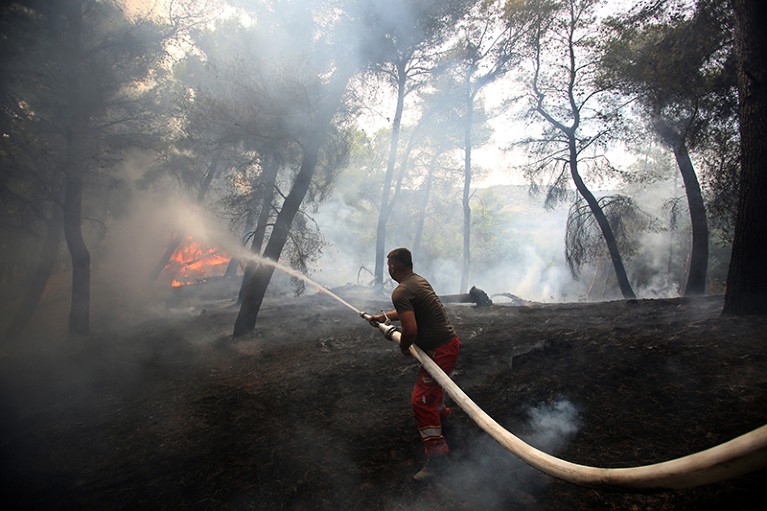
In 2023, wildfires spread rapidly through the village of Kraps near Fier, Albania. Credit: Adnan Beci/AFP via Getty
Inequity also affects the accuracy of climate models, because they rely on weather data — both historical and contemporary — and some regions are better resourced with meteorological infrastructure than are others, says Delta Merner, an environmental scientist at the Union of Concerned Scientists in Baltimore, Maryland. “There also are methodological gaps, particularly in under-resourced regions, where there’s not high-quality baseline data,” she says. “Without that baseline data, you’re not able to do the attribution science, or you’re not able to do it at the scale that the legal questions might require.”
Merner is currently working on a research project using machine learning to create synthetic data sets for under-resourced regions that lack consistent historical data, which could then aid the application of attribution science in those areas.
Attributing accountability
Since its emergence, climate-attribution science has broadened and diversified into multiple subfields.
The oldest of those is trend attribution, which looks for the signal of human influence over long-term climate trends, such as the link between rising global average surface temperatures and increasing atmospheric greenhouse-gas concentrations. Event attribution analyses whether climate change made a particular extreme event — a flood, storm or heatwave, for example — more likely to happen or more intense.
Climate models vary in their ability to model various extreme events, which can make it easier or harder to detect evidence of human-induced global warming. “Temperatures are easy,” says retired atmospheric scientist David Karoly at the University of Melbourne, Australia. “Particularly increases in extreme temperatures and the frequency of extreme temperatures; there’s been so much attribution of that that it’s actually quite difficult to get a paper published on that now.” Other extreme events such as storms, cyclones and fire weather are more challenging, either because those processes are not as well-represented in regional-scale climate models or because there are so many variables involved.
Source attribution aims to pin the responsibility for an impact to a source, such as a major emitter or nation. Lliuya chose to sue RWE because, at the time of the case, the company was Europe’s single largest emitter of greenhouse gases, and estimated to have contributed 0.47% of global industrial greenhouse-gas emissions since the start of the industrial age (see go.nature.com/3jb9apw). Although 0.47% seems like a small fraction, it’s highly significant — something that the court decision also recognized, Walker-Crawford says.
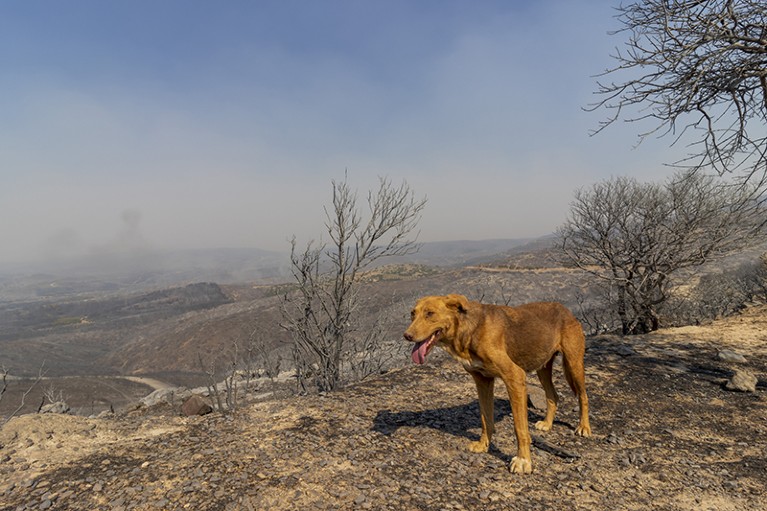
The frequency of wildfires in Greece is increasing. Credit: Athanasios Gioumpasis/Getty


